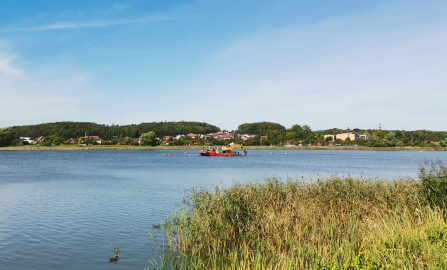Kartuzy Lakes, Poland
Successful restoration of four lakes complex, affected by domestic and industrial sewage in the past.
Site description
Kartuzy Lakes complex consists of four lakes - Mielenko Lake (area 0.079 km2, max depth 1.9 m), Karczemne Lake (area 0.40 km2, max depth 3.2 m), Klasztorne Małe Lake (area 0.139 km2, max depth 20 m) and Klasztorne Duże Lake (area 0.512 km2, max depth 8.0 m) - located in Kartuzy City. The lakes are connected by Klasztorna Struga Stream, forming a lake-river system. In the 20th century Kartuzy Lakes were subjected to massive pollution from the inflow of raw domestic and industrial wastewater, which led to a deterioration of their water quality. Particularly, lakes Karczemne and Klasztorne Małe were the most polluted, with dense blooms of phytoplankton and cyanobacteria, low water transparency, and with active internal loading of nitrogen (N) and phosphorus (P) from the polluted sediments. The main challenge for the restoration of good ecological status and water quality improvement is the high nutrient legacy present in the lake sediments. The main aim of the restoration measures taken is to restore the possible use of Kartuzy Lakes by the local community.
Restoration measures applied
On two lakes (Klasztorne Małe and Karczemne) artificial mixing was implemented in the 1980’s, but this had little effect. The first attempt of P inactivation (using LMB in 2006) on Klasztorne Małe Lake also failed. The main reason of failure was the lack of raw sewage diversion. Protective measures in the lakes’ catchment (modernisation of sewerage system and sewage diversion) were made in 2016-2018. Then it was possible to design proper restoration methods. Because of the active internal loading in Kartuzy Lakes, the P inactivation (using iron and aluminium coagulants) was implemented on all lakes (2020-2023). In shallow Karczemne Lake, where sediment P legacy was extremely high, sediment dredging was applied (removed sediment volume 240,000 m3) and P-inactivation was implemented after polluted sediment removal. Dredged sediment was directed to the local WWTP via a pipeline, where a special technological line was constructed for sediment treatment and transformation into fertilizer for agricultural use (Circular solution). In total, more than 1 million m3 of sediment-water mixture was treated. Biomanipulation of fish structure in lakes was also carried out as a supportive method throughout the whole project. All restoration activities were completed in 2023.
Current goals of restoration at the site
Current goal is observation of Kartuzy Lakes ecosystem reaction to applied restoration measures. Development of lakes use by local community, and social benefits analysis, as well as assessing sediment P application for agriculture as an example of developing a sustainable circular economy.
Sectors involved in lake basin management
Fisheries and angling sector, leisure and recreation.
Further reading
Augustyniak-Tunowska Renata, Karczmarczyk Rafał, Grochowska Jolanta K., Łopata Michał, Napiórkowska-Krzebietke Agnieszka, Lürling Miquel, 2024, Phosphorus inactivation mitigates the effect of warm winters in a temperate shallow lake (Mielenko Lake, Poland), Biogeochemistry, 2024, 1-25; DOI: 10.1007/s10533-024-01173-9
Grochowska Jolanta K., Goździejewska Anna, Augustyniak-Tunowska Renata, 2024, Changes in the Buffer Properties of the Restored Lake Complex, Sustainability, 2024, 16 (18), 1-17; DOI: 10.3390/su16187990
Grochowska Jolanta K., Łopata Michał, Augustyniak-Tunowska Renata, Tandyrak Renata, 2023, Sequential Application of Different Types of Coagulants as an Innovative Method of Phosphorus Inactivation, on the Example of Lake Mielenko, Poland, Sustainability, 2023, 15 (23), s. 1-13, DOI: 10.3390/su152316346
Kowalski Hubert, Grochowska Jolanta K., Łopata Michał, Augustyniak-Tunowska Renata, Tandyrak Renata, 2023, A Unique Application Methodology for the Use of Phosphorus Inactivation Agents and Its Effect on Phosphorus Speciation in Lakes with Contrasting Mixing Regimes, Water, 2023, 15 (1), s. 1-18; DOI: 10.3390/w15010067
Grochowska Jolanta K., Tandyrak Renata, 2021, The Influence of the Modernization of the City Sewage System on the External Load and Trophic State of the Kartuzy Lake Complex, Applied Sciences-Basel, 2021, 11 (3), s. 1-17; DOI: 10.3390/app11030974
Augustyniak Renata, Serafin Artur, 2021, Use of different adsorption models for characterizing P adsorption by the bottom sediment of four degraded urban lakes (Kashubian Lakeland, northern Poland), Desalination and Water Treatment
2021, 218, 6379, DOI: 10.5004/dwt.2021.26926
Grochowska Jolanta K., Augustyniak-Tunowska Renata, Łopata Michał, Płachta Anna, Kowalski Hubert, Karczmarczyk Rafał, 2022, The Impact of the Watershed Use Changes on the Water Chemistry of the Shallow, Urban Lake-A Case Study of Lake Mielenko (Pomeranian Lakeland, Poland), Water 2022, 14 (19), DOI: 10.3390/w14192943
Grochowska Jolanta K., Tandyrak Renata, Augustyniak Renata, Łopata Michał, Popielarczyk Dariusz, Templin Tomasz, 2021, How we can disrupt ecosystem of urban lakes- pollutants of bottom sediment in two shallow water bodies, Archives of Environmental Protection, 2021, 47 (4), s. 40-54; DOI: 10.24425/aep.2021.139501
Grochowska Jolanta K., Augustyniak Renata, Łopata Michał, Tandyrak Renata, 2020, Is it possible to restore a heavily polluted, shallow, urban lake? Applied Sciences-Basel, 2020, 10 (11), DOI: 10.3390/app10113698
Grochowska Jolanta K., 2020, Assessment of water buffer capacity of two morphometrically different degraded urban lakes, Water, 2020, 12,1512, DOI: 10.3390/w12051512
